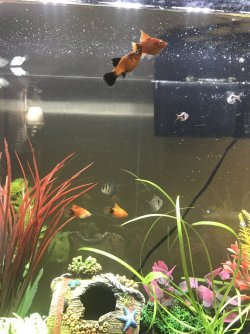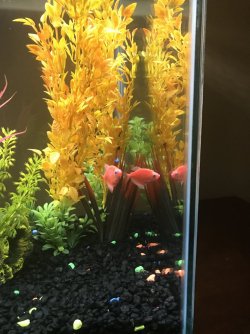What is the GH (general hardness), KH (carbonate hardness) and pH of your water supply?
This information can usually be obtained from your water supply company's website or by telephoning them. If they can't help you, take a glass full of tap water to the local pet shop and get them to test it for you. Write the results down (in numbers) when they do the tests. And ask them what the results are in (eg: ppm, dGH, or something else).
Depending on what the GH of your water is, will determine what fish you should keep. Tetras, barbs, gouramis, rasbora, Corydoras and small species of suckermouth catfish all occur in soft water (GH below 150ppm) and a pH below 7.0.
Livebearers (guppies, platies, swordtails, mollies) occur in medium hard water with a GH around 200-250ppm and a pH above 7.0.
If you have very hard water (GH above 300ppm) then look at African Rift Lake cichlids or use distilled or reverse osmosis water to reduce the GH.
Having a combination of tetras, rasboras and livebearers will cause problems in the long run. If you have hard water, the livebearers will do well but the others will suffer. If the water is soft, the livebearers will suffer but the others will be fine.
---------------------
You need a picture on the back of the tank to make the fish feel more secure.
---------------------
Stress from tank lights coming on when the room is dark can be an issue. Fish don't have eyelids and don't tolerate going from complete dark to bright light (or vice versa) instantly.
In the morning open the curtains or turn the room light on at least 30 minutes (or more) before turning the tank light on. This will reduce the stress on the fish and they won't go from a dark tank to a bright tank instantly.
At night turn the room light on and then turn the tank light off. Wait at least 30 minutes (or more) before turning the room light out. This allows the fish to settle down for the night instead of going from a brightly lit tank to complete darkness instantly.
---------------------
Don't feed the fish until the tank lights have been on for at least an hour. this gives the fish time to wake up start looking for food.
Adult fish that aren't breeding can be fed once a day on a variety of dry, frozen and live foods.
The following link has information about culturing food for baby fish but many of the foods can also be fed to small fish like what you have.
STARTING OUT Make sure you have a pair, (1 male + 1 female). There is nothing worse than spending your hard-earned dollars buying a couple of fish to try and breed and ending up with a pair of fish of the same sex. Let's face it, to reproduce fish you need a male and a female. Two males won't do...

www.fishforums.net
---------------------
Do a 75% water change and gravel clean the substrate once a week.
Make sure any new water is free of chlorine/ chloramine before it's added to the tank.
Clean the filter at least once a month and every 2 weeks is great.
Wash filter media/ materials in a bucket of tank water and re-use the media. Tip the bucket of dirty water on the lawn.
Don't use carbon or ammonia removing granules in filters because they aren't necessary. Sponges are the best type of filter media and will last 10+ years.
---------------------
The following link has information about what to do if your fish get sick. It's long and boring but worth a read when you have some spare time.
If your fish ever looks sick or unwell, then the following steps might help. Test the Water and Clean the Tank. Test the water quality for ammonia, nitrite, nitrate and pH and write the results down in numbers. Check it for general hardness (GH) and carbonate hardness (KH) too if you can, but...

www.fishforums.net






 /s1091480.instanturl.net/2020waterreport/pdfs/Distribution Area 12.pdf#zoom=125
/s1091480.instanturl.net/2020waterreport/pdfs/Distribution Area 12.pdf#zoom=125